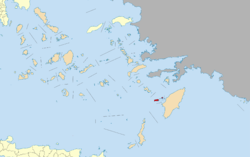Halki (Greece)
|
Halki (or Chalki) Χάλκη |
|
|---|---|

The port of Emporio
|
|
| Coordinates: 36°14′N 27°34′E / 36.233°N 27.567°ECoordinates: 36°14′N 27°34′E / 36.233°N 27.567°E | |
| Country | Greece |
| Administrative region | South Aegean |
| Regional unit | Rhodes |
| Area | |
| • Municipality | 37.04 km2 (14.30 sq mi) |
| Highest elevation | 601 m (1,972 ft) |
| Lowest elevation | 0 m (0 ft) |
| Population (2011) | |
| • Municipality | 478 |
| • Municipality density | 13/km2 (33/sq mi) |
| Time zone | EET (UTC+2) |
| • Summer (DST) | EEST (UTC+3) |
| Postal code | 851 10 |
| Area code(s) | 22460 |
| Vehicle registration | ΚΧ, ΡΟ, ΡΚ |
| Website | www |
Halki (Greek: Χάλκη; alternatively Chalce or Chalki) is a Greek island and municipality in the Dodecanese archipelago in the Aegean Sea, some 6 km (4 mi) west of Rhodes. With the area of 28 km2 (11 sq mi), it is the smallest inhabited island of Dodecanese. It is part of the Rhodes regional unit. It has permanent population of 330 (increased during the summer months), concentrated in the only village Emborio. The 2011 census showed a population of 478 inhabitants. The community is divided in two parts, Chorio (also spelled Horio - the village) Χωριό and Emporio Εμποριό (the market).
The island supported a much larger population but following emigration in the mid-20th century Chorio was almost completely abandoned. A sizable group of the residents moved to Tarpon Springs, Florida, establishing the Greek-American community there that continues to this day. A ruined medieval castle of the Knights of St. John overlooks the old town and the chapel contains some of the original frescoes.
List of Halki rulers:
The Municipality of Chalki includes several uninhabited offshore islands, the largest of which is Alimia to the northeast, and has a total land area of 37.043 square kilometres (14.302 sq mi). The island's primary industry is tourism, although fishing is also substantial. There is virtually no natural water supply on the island and rainfall is collected in large cisterns. Drinking water is brought in from Rhodes but there can be shortages during the summer months with the increased population. As of 2014[update] there is a desalination plant on the island and the water boat no longer comes every few days. However, bottled water still arrives.
...
Wikipedia


